Can consumer wearable activity tracker-based interventions improve physical activity and cardiometabolic health in patients with chronic diseases? A systematic review and meta-analysis of randomised controlled trials
- PMID: 32393357
- PMCID: PMC7216601
- DOI: 10.1186/s12966-020-00955-2
Can consumer wearable activity tracker-based interventions improve physical activity and cardiometabolic health in patients with chronic diseases? A systematic review and meta-analysis of randomised controlled trials
Abstract
Background: To date, it is unclear if consumer wearable activity trackers (CWATs), with or without behaviour multi-component strategies, effectively improve adherence to physical activity and health outcomes under free living conditions in populations with chronic diseases. Therefore, we systematically evaluated the efficacy of CWAT-based interventions to promote physical activity levels and cardiometabolic health in populations with chronic diseases.
Methods: Randomised controlled trials were collected from five bibliographic databases (PubMed, Embase, Web of Science, The Cochrane Central Register of Controlled Trials and CINAHL). Studies were eligible for inclusion if they evaluated a CWAT-based counselling intervention versus control intervention among patients with chronic respiratory diseases, type 2 diabetes mellitus, cardiovascular diseases, overweight/obesity, cognitive disorders, or sedentary older adults. Data were pooled using a random-effects model.
Results: After deduplication 8147 were identified of which 35 studies met inclusion criteria (chronic respiratory diseases: 7, type 2 diabetes mellitus: 12, cardiovascular diseases: 6, overweight/obesity: 3, cognitive disorders: 1, sedentary older adults: 6). Compared to control groups, CWAT-based interventions significantly increased physical activity by 2123 steps per day (95% confidence interval [CI], [1605-2641]; p < 0.001). In addition, CWAT-based interventions in these populations significantly decreased systolic blood pressure (- 3.79 mm Hg; 95% CI: [- 4.53, - 3.04] mm Hg; p < 0.001), waist circumference (- 0.99 cm; 95% CI: [- 1.48, - 0.50] cm; p < 0.001) and low-density lipoprotein cholesterol concentration (- 5.70 mg/dl; 95% CI: [- 9.24, - 2.15] mg/dl; p = 0.002).
Conclusion: CWAT-based interventions increase physical activity and have beneficial effects on important health-related outcomes such as systolic blood pressure, waist circumference and LDL cholesterol concentration in patients with chronic diseases.
Keywords: Activity tracker; Cardiometabolic health; Chronic disease; Physical activity.
Conflict of interest statement
The authors declare that they have no competing interests.
Figures



Similar articles
-
A 12-week consumer wearable activity tracker-based intervention reduces sedentary behaviour and improves cardiometabolic health in free-living sedentary adults: a randomised controlled trial.J Act Sedentary Sleep Behav. 2022 Dec 1;1(1):8. doi: 10.1186/s44167-022-00007-z. J Act Sedentary Sleep Behav. 2022. PMID: 40229981 Free PMC article.
-
Consumer-Based Wearable Activity Trackers Increase Physical Activity Participation: Systematic Review and Meta-Analysis.JMIR Mhealth Uhealth. 2019 Apr 12;7(4):e11819. doi: 10.2196/11819. JMIR Mhealth Uhealth. 2019. PMID: 30977740 Free PMC article.
-
Association Between Patient Factors and the Effectiveness of Wearable Trackers at Increasing the Number of Steps per Day Among Adults With Cardiometabolic Conditions: Meta-analysis of Individual Patient Data From Randomized Controlled Trials.J Med Internet Res. 2022 Aug 30;24(8):e36337. doi: 10.2196/36337. J Med Internet Res. 2022. PMID: 36040779 Free PMC article. Review.
-
Activity Tracker-Based Metrics as Digital Markers of Cardiometabolic Health in Working Adults: Cross-Sectional Study.JMIR Mhealth Uhealth. 2020 Jan 31;8(1):e16409. doi: 10.2196/16409. JMIR Mhealth Uhealth. 2020. PMID: 32012098 Free PMC article.
-
Interventions Using Wearable Physical Activity Trackers Among Adults With Cardiometabolic Conditions: A Systematic Review and Meta-analysis.JAMA Netw Open. 2021 Jul 1;4(7):e2116382. doi: 10.1001/jamanetworkopen.2021.16382. JAMA Netw Open. 2021. PMID: 34283229 Free PMC article.
Cited by
-
Digital Biomarker-Based Interventions: Systematic Review of Systematic Reviews.J Med Internet Res. 2022 Dec 21;24(12):e41042. doi: 10.2196/41042. J Med Internet Res. 2022. PMID: 36542427 Free PMC article.
-
Physical Activity Evaluation Using Activity Trackers for Type 2 Diabetes Prevention in Patients with Prediabetes.Int J Environ Res Public Health. 2022 Jul 6;19(14):8251. doi: 10.3390/ijerph19148251. Int J Environ Res Public Health. 2022. PMID: 35886100 Free PMC article.
-
Physical activity and sedentary behaviour of Bahraini people with type 2 diabetes: A cross-sectional study.Digit Health. 2024 May 17;10:20552076241251997. doi: 10.1177/20552076241251997. eCollection 2024 Jan-Dec. Digit Health. 2024. PMID: 38766358 Free PMC article.
-
Impact of wearable device-based interventions with feedback for increasing daily walking activity and physical capacities in cardiovascular patients: a systematic review and meta-analysis of randomised controlled trials.BMJ Open. 2023 Jul 11;13(7):e069966. doi: 10.1136/bmjopen-2022-069966. BMJ Open. 2023. PMID: 37433730 Free PMC article.
-
Wearables and Smartphones for Tracking Modifiable Risk Factors in Metabolic Health: Protocol for a Scoping Review.JMIR Res Protoc. 2024 Nov 28;13:e59539. doi: 10.2196/59539. JMIR Res Protoc. 2024. PMID: 39608004 Free PMC article.
References
-
- Organization WH. Global action plan for the prevention and control of noncommunicable diseases 2013–2020. Geneva; 2013.
-
- Vos T, Barber RM, Bell B, Bertozzi-Villa A, Biryukov S, Bolliger I, et al. Global, regional, and national incidence, prevalence, and years lived with disability for 301 acute and chronic diseases and injuries in 188 countries, 1990–2013: a systematic analysis for the global burden of disease study 2013. Lancet. 2015;386(9995):743–800. doi: 10.1016/S0140-6736(15)60692-4. - DOI - PMC - PubMed
-
- WHO. Global action plan for the prevention and control of noncommunicable diseases. 2013–2020:2013.
Publication types
MeSH terms
Substances
LinkOut - more resources
Full Text Sources
Medical
Miscellaneous

